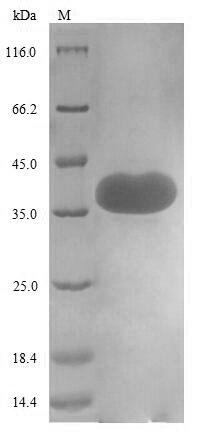The production of recombinant human CD44 antigen involves synthesizing the human CD44 (21-220aa)-encoding gene. This gene is co-cloned into an expression vector with an N-terminal 6xHis-SUMO-tag gene and introduced into E. coli cells via transfection. The positive E. coli cells are selected and cultured to express the recombinant protein. After that, these cells are lysed to release the recombinant CD44 protein, which is purified by affinity chromatography. The recombinant CD44 protein's purity is assessed by SDS-PAGE, exceeding 85%.
CD44 antigen is involved in multiple biological activities such as lymphocyte activation, matrix adhesion, and facilitating the attachment of lymphocytes to lymph node high endothelial venules (HEVs) [1]. CD44 functions as a lymph node-homing receptor on circulating lymphocytes [2]. CD44 is also a receptor for hyaluronan (HA) and is crucial for cell-extracellular matrix interactions [3].
Furthermore, CD44 has been associated with various medical conditions. Evidence has revealed that up-regulation of CD44 is found in fibrous astrocytes in demyelinating diseases like multiple sclerosis [4]. CD44 expression has been detected along with other antigens like CD10 and alkaline phosphatase in osteoblasts present in human bone tissue sections [5]. Studies have shown that CD44 is involved in colorectal carcinomas and adenomatous polyps [6].
References:
[1] I. Stamenkovic, A. Aruffo, M. Amiot, & B. Seed, The hematopoietic and epithelial forms of cd44 are distinct polypeptides with different adhesion potentials for hyaluronate-bearing cells., The Embo Journal, vol. 10, no. 2, p. 343-348, 1991. https://doi.org/10.1002/j.1460-2075.1991.tb07955.x
[2] G. Screaton, M. Bell, D. Jackson, F. Cornelis, U. Gerth, & J. Bell, Genomic structure of dna encoding the lymphocyte homing receptor cd44 reveals at least 12 alternatively spliced exons., Proceedings of the National Academy of Sciences, vol. 89, no. 24, p. 12160-12164, 1992. https://doi.org/10.1073/pnas.89.24.12160
[3] M. Telen, M. Udani, M. Washington, M. Levesque, E. Lloyd, & N. Rao, A blood group-related polymorphism of cd44 abolishes a hyaluronan-binding consensus sequence without preventing hyaluronan binding, Journal of Biological Chemistry, vol. 271, no. 12, p. 7147-7153, 1996. https://doi.org/10.1074/jbc.271.12.7147
[4] S. Alldinger, S. Fonfara, E. Kremmer, & W. Baumgärtner, Up-regulation of the hyaluronate receptor cd44 in canine distemper demyelinated plaques, Acta Neuropathologica, vol. 99, no. 2, p. 138-146, 2000. https://doi.org/10.1007/pl00007417
[5] L. Díaz-Rodríguez, O. García-Martínez, M. Arroyo-Morales, C. Reyes-Botella, & C. Ruiz, Antigenic phenotype and phagocytic capacity of mg‐63 osteosarcoma line, Annals of the New York Academy of Sciences, vol. 1173, no. s1, 2009. https://doi.org/10.1111/j.1749-6632.2009.04950.x
[6] K. Heider, M. Hofmann, E. Hors, F. Berg, H. Ponta, P. Herrlichet al., A human homologue of the rat metastasis-associated variant of cd44 is expressed in colorectal carcinomas and adenomatous polyps., The Journal of Cell Biology, vol. 120, no. 1, p. 227-233, 1993. https://doi.org/10.1083/jcb.120.1.227






